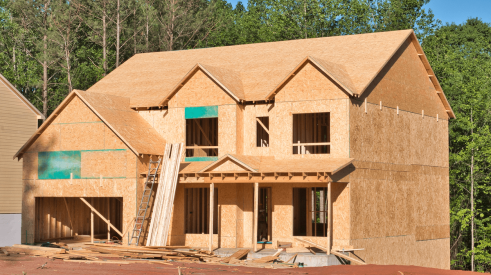|
The U.S. population continues to increase. Annual household growth is expected to rise by an average of more than 1.5 million for the 2009 to 2012 period. Affordability has leapt to its highest levels since the 1970s. Mortgage rates are lower than when even our grandfathers would remember.
Someone will have to be there when the house hunters return to the market. And it's important to note that what's happening in the housing market in Sarasota, Fla., isn't necessarily what's happening in Buffalo, N.Y., Austin, Texas, or Portland, Ore. Home building will always be a business tied to the local market.
|
Online Extra: The NAHB is expanding their efforts on the AD&C lending crisis with a new game plan that’s focused on their membership. The centerpiece of their effort calls for developing solid and specific case studies that illustrate the AD&C crisis that builders and developers are experiencing. they are asking members to share their experiences. (Note: You need to be a NAHB member to participate) |
But there's a serious threat right now to meeting future demand. In many markets, the collar has rapidly tightened on builders who've been looking to fund their next project. Home builders who do find the bank or private or institutional equity source that will talk with them are encountering new, different and more stringent requirements: — more cash equity, additional collateral, guarantor support, additional loan fees, higher interest rates or higher returns.
What's even worse is that the leash is being severely shortened on builders who have projects under way. Regulators are forcing banks to reduce their real-estate exposure and clear balance sheets of "nonperforming" loans. Property is being reappraised in a distressed market environment where comparables include foreclosed properties sold at auction, builder short sales or banks' unloading REO at ridiculously deep discounts. In a mounting number of extreme cases, banks are calling in existing loans, forcing home building firms into bankruptcy and out of business. These builders are finding there's virtually nowhere else to turn for cash.
Have all the capital sources for land acquisition, land development and home construction (AD&C) gone astray? With this unprecedented scenario as a backdrop, we went looking to find what sources, if any, may be out there for AD&C.
 |
NAHB Senior Vice president for Housing Finance and Land Development
David Ledford's department serves the membership of the NAHB on finance and land development issues.
"In most cases, banks are not able to do AD&C loans," says David Ledford of this current lending environment. He notes that builders who have solid contracts to build homes have a difficult time, too. Still, there's hope. Although it might vary by market, banks might lend if there's an existing relationship, Ledford says.
Other private funds and investors are out there looking for profitable investments but "their fees are high, the terms are tougher and they are much harder to find.
"The general feeling out there right now is 'we don't need to build any more houses,'" Ledford says. He predicts this attitude will lead to future housing shortages in many markets. "The inventory isn't going to be there when the recovery process starts," he believes. "The big question is when the turning point will be."
 |
Principal, R W Kline
R W Kline is a Scottsdale, Ariz.-based national firm that specializes in full-service asset solutions, acquisitions and land development.
"There isn't a whole lot of private equity money out there [for AD&C] right now, unfortunately," says Bob Kline. "New appraisals are so low."
Kline says that builders pursuing potential private equity sources would need to "be willing to share a significant piece of the pie." He adds that private funds are looking for 30 to 50 percent of the upside.
Kline points out that all markets may not be in the same dire situation that others are. "If someone's in a market where the conditions are right, some commercial lenders will probably look at a project."
As far as when the money for AD&C might be found again, Kline says it won't happen "unless the mark to market rules are adjusted or until the market starts moving the other way." Lending institutions are in a dilemma right now. "How can you mark to market if you don't know what the market is?"
 |
President, Rosenthal Co.
The Crystal Lake, Ill.-based Rosenthal Co. develops residential and commercial properties. Tom Stephani is also a nationally recognized speaker and trainer on issues relating to the residential construction industry.
"Getting loans for spec housing is impossible right now. Loans are non-existent from traditional sources," says Stephani. "The non-traditional sources are scared to death because the market is so saturated. Private investors are asking 'why would we want to do that that now?'
"Dirt is worthless," he continues. "The only value might be in the infrastructure that's in place. If you want to do speculative housing, you have to do it with 100 percent cash. Other than that, there may be friends and family that truly believe in you willing to lend money. But building anything on spec is a crap shoot right now.
"Whatever I would build now, appraisers will tell me the value is less than what it took to build. The freefall of foreclosures and short sales has to stop," Stephani says.
Stephani says there may be opportunities in the current market for builders who are able to use the customer's equity to build a specific home on a specific lot. Demand could also come from customers wanting new green features that aren't available anywhere else. Other examples would be customers who need special features built into their home for aging in place or disabilities.
"There is light at the end of the tunnel somewhere, but it will take awhile," he says.
 |
Senior Advisor, Americrest Homes
Boca Raton, Fla.-based Americrest Homes is a start-up builder with equity capital focused on finding opportunities in distressed land.
Tony Avila says that home builders can try the smaller local and regional banks, but the chances of finding any willing to lend on AD&C financing may be "few and far between." Money center banks such as Bank of America, Wachovia/Wells and JPMorgan/Chase are busy reducing their exposure to home building and not lending to new clients.
When builders do find a willing bank, they most likely will find the banks won't want to place any loans on the raw land and will offer only partial funding for development and construction — 60 percent to 70 percent as opposed to 100 percent advance rates. Builders will also find the terms of the loan will be much steeper — Libor plus 350, 450 points or higher, instead of Libor plus 125 to 250 points.
Other financing sources for builders could include "private debt and equity funds, hedge funds, family, friends or high net worth family offices," he says, adding that private equity sources are still viable and that his firm is currently working on assignments for builders to find new pools of debt capital.
TALKBACK: We welcome any homebuilders who have been successful in finding loans for AD&C to share their success story by using our Talkback feature found at the bottom of the page.
|
Advertisement
Related Stories
Single-Family Homes
What Does It Cost to Build a Single-Family Home?
A closer look at the itemized costs in each stage of construction for a single-family home
Builders
A Look at the Boom in Home Builder Stocks During 2023
In 2023, stocks for the 10 biggest U.S. home builders outperformed the S&P 500. What does that say about the housing market?
Financials
Housing Demand Could Rebound in 2024 as Mortgage Rates Ease
The Mortgage Bankers Association predicts lower mortgage rates could bring homebuyers back into the market in 2024







